Telescope observations of a halo around a nearby galaxy could help clarify how 'stellar streams' are formed.
Using a Japanese telescope on top of the sacred Hawaiian mountain of Mauna Kea, researchers have identified 11 dwarf galaxies and two star-containing halos in the outer region of a large spiral galaxy 25 million light-years away from Earth. The findings, published in The Astrophysical Journal, provide new insight into how these 'tidal stellar streams' form around galaxies.
Researchers from Tohoku University and colleagues used an ultra-wide field of view camera on the Subaru Telescope to develop a better understanding of stellar halos. These ring-shaped collections of stars orbit large galaxies and can often originate from smaller dwarf galaxies nearby.

Eleven dwarf galaxies and two star-containing halos were identified in the outer region of the nearby Whale Galaxy.
(Credit: Tohoku University / National Astronomical Observatory of Japan)
The team focused their attention on Galaxy NGC 4631, otherwise known as the Whale Galaxy because of its shape. They identified 11 dwarf galaxies in its outer region, some of which were already known. Dwarf galaxies are not easily detected because of their small sizes, masses and low brightness. The team also found two tidal stellar streams orbiting the galaxy: one, called Stream SE, is located in front of it and the other, called Stream NW, is nestled behind it.
Based on calculations aiming to estimate the metallic content of the stellar streams, the team believes it's possible that they originated as a result of a gravitational interaction between the Whale Galaxy and a dwarf galaxy orbiting it.The team focused their attention on Galaxy NGC 4631, otherwise known as the Whale Galaxy because of its shape. They identified 11 dwarf galaxies in its outer region, some of which were already known. Dwarf galaxies are not easily detected because of their small sizes, masses and low brightness. The team also found two tidal stellar streams orbiting the galaxy: one, called Stream SE, is located in front of it and the other, called Stream NW, is nestled behind it.
The team also found that both streams are relatively fainter than other stellar streams that have been studied around galaxies close to the Milky Way. Stream NW is the brighter of the pair, and has a more concentrated core. The researchers hypothesize that this brightness is due to a dwarf galaxy, possibly embedded within it, and that this dwarf had a gravitational interaction with the Whale Galaxy to form Stream SE.

Dwarf galaxies discovered by observation. Three color composites are characterized by HSC-g and HSC-i images. A pseudo-image with intermediate color is created from the averaged image of HSC-g and HSC-i images. The top right column (3) was previously thought to be a dwarf galaxy from an earlier study, but from the high resolution image taken by HSC, it is apparent that what was observed was an overlapping of foreground stars and background galaxies.
(Credit: Tohoku University / National Astronomical Observatory of Japan)
It is thought that stellar halos are less common when a galaxy's total stellar mass is smaller than the stellar mass of larger galaxies, such as the Triangulum Galaxy. As a result of their calculations, the researchers believe that the Whale Galaxy, although large, has a smaller mass than the Milky Way. Nonetheless, it is still in an active growth phase, and so are its surrounding halos. Future studies could help further clarify how stellar halos form around galaxies with relatively small masses, the researchers conclude.
- Publication Details:
Title: Resolved Stellar Streams around NGC 4631 from a Subaru/Hyper Suprime-Cam Survey
Authors: Mikito Tanaka, Masashi Chiba, and Yutaka Komiyama
Journal: The Astrophysical Journal
DOI: 10.3847/1538-4357/aa6d11
Contact:
Mikito TanakaFrontier Research Institute for Interdisciplinary Sciences
Tohoku University
Email: mikito@astr.tohoku.ac.jp

